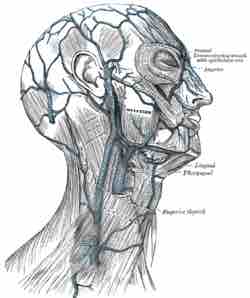Two main jugular veins are responsible for the venous draining of the head and neck.
The superficial external jugular vein is formed from the retromandibular vein and the posterior auricular vein at a point adjacent to the mandible. The external jugular vein passes down the neck and underneath the clavicle before draining into the subclavian vein.
The deep-lying internal jugular vein receives blood from the dural venous sinuses in the brain as well as the cerebral and cerebellar veins. Dural sinuses are composed of dural mater lined with endothelium, making them distinct from arteries, veins, and capillaries. The dural sinuses receive blood from the veins that drain the brain and skull.
Formed at the base of the brain from the inferior petrosal sinus and the sigmoid sinus, the internal jugular vein runs down the side of the neck adjacent to the internal carotid artery. As well as removing blood from the brain, the anterior retromandibular, facial, and lingual veins also drain into the internal jugular. Upon exiting the neck, the internal jugular vein merges with the subclavian vein to form the brachiocephalic vein.
Additional veins such as the occipital, deep cervical, and thyroid veins drain directly into the brachiocephalic vein.

Veins of the Head and Neck
The veins of head and neck are labeled in blue, with an arrow pointing to the auricular vein.